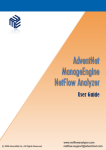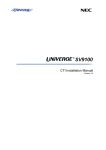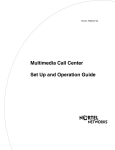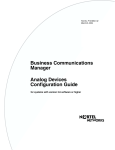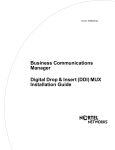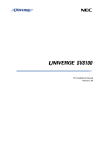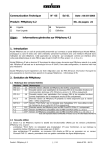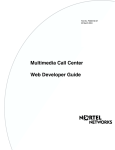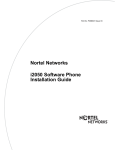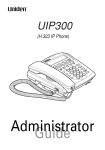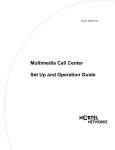Download Avaya BCM 2.5 Upgrade Guide
Transcript
Part No. P0987357 02 Business Communications Manager 2.5 Upgrade Guide 2 How to get help USA and Canada Authorized Distributors - ITAS Technical Support Telephone: 1-800-4NORTEL (1-800-466-7835) If you already have a PIN Code, you can enter Express Routing Code (ERC) 196#. If you do not yet have a PIN Code, or for general questions and first line support, you can enter ERC 338#. Website: http://www.nortelnetworks.com/itas/ email: [email protected] Presales Support (CSAN) Telephone: 1-800-4NORTEL (1-800-466-7835) Use Express Routing Code (ERC) 1063# EMEA (Europe, Middle East, Africa) Technical Support - CTAS Telephone: 00800 800 89009 or 33 4 9296 1341 Fax: 33 49296 1598 email: [email protected] CALA (Caribbean & Latin America) Technical Support - CTAS Telephone: 1-954-858-7777 email: [email protected] APAC (Asia Pacific) Technical Support - CTAS Telephone: +61 388664627 Fax: +61 388664644 email: [email protected] P0987357 02 3 Business Communications Manager 2.5 Upgrade To perform the Business Communications Manager upgrade 1. Determine whether you can perform the upgrade You can perform the upgrade on a Business Communications Manager platform only. Do not perform the upgrade on an Enterprise Edge 1.0 hardware platform. To determine whether you have an Enterprise Edge or a Business Communications Manager platform, check the Comm Port connectors. If the ports are multicolored you have a Business Communications Manager platform and can perform the upgrade. If the ports are not multicolored, you have an Enterprise Edge 1.0 hardware platform and cannot perform the upgrade. 2. Ask the system administrator to request that subscribers delete their old voicemail messages Ask the System Administrator to request that subscribers delete their old voicemail messages. Fewer messages enables the system to upgrade faster. During the upgrade, the message storage format is converted to a new format (from SBC to G711.) 3. Record the 2.0.3 configuration data Use the tables in “Business Communications Manager 2.0.3 Configuration Information” on page 39 to record your 2.0.3 settings. After the upgrade, you must confirm that settings marked with ? are present on the system. If not, reapply the settings using the values you recorded in these tables. 4. Print the Call Center Reporting Configuration Report If you use Call Center Reporting, print the Configuration Report so you have a record of your configuration. Have the report handy during the upgrade. After the upgrade is complete you must manually re-enter the settings for skillset statistical thresholds, print schedules and wallboard information. 5. Perform the upgrade Follow the instructions: • “Performing the upgrade” on page 7 • “Installing the DRAM” on page 33 • “Installing the MS-PEC III cards” on page 37 Business Communications Manager 2.5 Upgrade Guide 4 Business Communications Manager 2.5 Upgrade 6. Verify the upgrade is successful and reapply the configuration data Follow the instructions for the “Post-upgrade system check” on page 23 and confirm that settings marked with ? that you recorded in the “Business Communications Manager 2.0.3 Configuration Information” on page 39 are present on the system. If not, reapply the settings using the values you recorded in these tables. 7. Upgrade the clients Follow the instructions “Upgrading clients” on page 28. You must upgrade the client applications. Note: After you upgrade your Business Communications Manager system to 2.5 you cannot return it to 2.0.3. After you start the upgrade, do not stop or interrupt the upgrade. P0987357 02 Business Communications Manager 2.5 Upgrade 5 Prerequisites for installing the upgrade Warning: When you insert or remove the MS-PEC cards, be careful not to contact the MS-PEC cards with the MSC Printed Circuit Board. Incorrect handling of the MS-PEC cards during installation can result in the loss of telephony programming. Note: During the upgrade, your Business Communications Manager system, including the telephony resources, is not functional. Caution: You must wear an antistatic grounding strap at all times when you handle electronic components. Failure to do so can result in damage to the equipment or loss of telephony programming. For your system • Your Business Communications Manager system must be at 2.03. If your system is not at 2.03, refer to the Readme.html file on the 2.03 upgrade CD. Note: Fax over IP is not available for Business Communications Manager 2.5. If you use Fax over IP, assess the impact of losing this capability before you begin the upgrade. • Do not pre-install the DRAM or the MS-PEC III cards. You install these during the upgrade. Note: If there are any mapped network drives on Business Communications Manager that are used by BRU, disconnect (unmap) these drives using VNC before you start the upgrade. • Log out of any VNC sessions and quit any open Windows applications. Note: Do not open any VNC or Unified Manager sessions while you perform the upgrade. These sessions can interfere with the progress of the upgrade. VNC access to the system is not automatically enabled in Business Communications Manager 2.5. For the computer you use to do the upgrade • Make sure your browser is set to check for newer versions of stored pages on every visit to the page, and you have cookies enabled. Refer to your browser’s online Help for details. Warning: Netscape is not supported to perform this upgrade. Only Internet Explorer 5.0 or 5.5 is supported. • You must use a computer that is on the same network as your Business Communications Manager system. Business Communications Manager 2.5 Upgrade Guide 6 Business Communications Manager 2.5 Upgrade • We strongly recommend that you use a computer that is within the same subnet as the Business Communications Manager system that you are upgrading. • You must know how to share folders. If you use Windows 95, 98 or Me, you must enable file sharing. Refer to your Windows system documentation for how to share folders. For VoIP Trunking • Check the VoIP Remote Gateways that are configured on the Business Communications Manager 2.0.3 system. The Business Communications Manager system allows Remote Gateway names that are a maximum of 15 characters. If you have any Remote Gateways with names that are longer than 15 characters, or that contain spaces, rename the Remote Gateways so they are a maximum of 15 characters long and do not contain spaces. To rename the Remote Gateway, in Unified Manager remove the Remote Gateway and re-enter the Remote Gateway with the modified name. For voicemail • If you change the time zone setting for the Business Communications Manager system, all voicemail messages stored before the time zone change will be inaccessible. It is highly recommended that you select the time zone as one of the first items configured on the Business Communications Manager and that you do not change it. If it is necessary to change the time zone, notify subscribers to delete all stored messages in their mailboxes. You must reboot the Business Communications Manager system after you change the time zone. This information applies to Business Communications Manager 2.0.3 and 2.5 systems. You are now ready to start the upgrade. The upgrade can take approximately two to three hours. Note: A backup of the core telephony configuration is performed during the upgrade process. This backup is used during the upgrade to restore the core telephony configuration, if necessary. This backup can be used on BCM systems that have been upgraded from BCM 2.0.3 to BCM 2.5 but it cannot be used on systems that were purchased with BCM 2.5 software. P0987357 02 Business Communications Manager 2.5 Upgrade 7 Performing the upgrade Note: If the upgrade is interrupted before you have entered all the information, you must restart the upgrade. If the upgrade is interrupted after you have entered all the information, you must re-connect to the upgrade. 1 Insert the Disk 1 CD into your CD-ROM drive. You must install Disk 1 before you install Disk 2. If your CD-ROM drive is configured to run automatically, the BCM 2.5 Upgrade Wizard page appears. If your CD-ROM drive does not run automatically, double-click index.html. The BCM 2.5 Upgrade Wizard page appears. 2 Click the Begin Upgrade button. The Pre-Upgrade Checklist page appears. Note: During the upgrade: • Do not use your browser’s Back, Forward or Refresh buttons. • Do not open any documents or web pages that can use the browser window. Business Communications Manager 2.5 Upgrade Guide 8 Business Communications Manager 2.5 Upgrade 3 After you read the upgrade conditions, click the Next button. The Validate BCM Address Page appears. Note: If at any time you see a “Page not displayed or Internal Server Error” message: • Close your browser. DO NOT click Refresh. • Remove and reinsert the CD if your CD-ROM runs automatically, or double-click index.html to resume the upgrade. The BCM 2.5 Upgrade Wizard page appears. • Click the Reconnect to Upgrade button. • Follow steps 4 through 8. You return to the page where the upgrade currently is and can continue the procedure. 4 In the BCM Address box type the IP address, DNS, network name or the Fully Qualified Domain Name of the Business Communications Manager system. It is recommended that you use the IP address. 5 Click the Validate BCM Address button. The Enter Network Password dialog box appears. 6 In the User name box type your Business Communications Manager user name. The default Business Communications Manager user name is supervisor. If you cannot use your Business Communications Manager user name, use the default user name. When the upgrade is complete, you can resume using your user name. 7 In the Password box type your Business Communications Manager password. The default Business Communications Manager password is visor. If you cannot use your Business Communications Manager password, use the default password. When the upgrade is complete, you can resume using your password. 8 Click the OK button. A message appears that the address is validated. P0987357 02 Business Communications Manager 2.5 Upgrade 9 9 Click the OK button. The Sharing Your CD-ROM page appears. 10 Follow the steps for sharing your folder. Refer to your system documentation for how to share folders. 11 Click the Next button. The Connect to Upgrade CD page appears. 12 In the Host box type the IP address, DNS, network name or Fully Qualified Domain Name of the computer you are using. 13 In the Share Name box type the share name you created for the installation files when you created the shared folder. Business Communications Manager 2.5 Upgrade Guide 10 Business Communications Manager 2.5 Upgrade 14 In the User Name box type your hostname\username or domainname\username. Note: Be sure to type the information in the User Name box as hostname\username or domainname\username. 15 In the Password box type your password. 16 Click the Connect to CD button. In the lower frame a message appears that you are connected. Note: Check that you are connected before you go to the next step. 17 Click the Next button. The Prepare BCM page appears. P0987357 02 Business Communications Manager 2.5 Upgrade 11 18 Click the Prepare BCM Now button. The status is shown in the lower frame. The Upgrade Preparation page appears. 19 Click the Next button. The Verifying System Requirements & MSC Core page appears. Business Communications Manager 2.5 Upgrade Guide 12 Business Communications Manager 2.5 Upgrade 20 Click the Next button. The Configure RAS IP Address Range page appears. 21 Make sure that the Network Range and the Network Mask values in the Recommended boxes are accurate, then click the Apply Values button.In most cases you can accept the accept the settings that are shown. 22 Click the Next button. The Settings page appears. P0987357 02 Business Communications Manager 2.5 Upgrade 13 23 Your MSC core variant is automatically detected. From the Region list box select your region. Select the setting you had for Country for Business Communications Manager 2.0.3. 24 If you use IPX routing, select Yes. If you do not use IPX routing, leave this at the default setting of No. 25 Click the Next button. A message appears that confirms the core that will be uploaded. Business Communications Manager 2.5 Upgrade Guide 14 Business Communications Manager 2.5 Upgrade 26 Click the OK button. The Begin Upgrade screen appears. 27 If you want audio notification during the upgrade, leave the Audible Install as Yes or if you do not want audio notification, from the Audible Install list box select No. Yes is the default. 28 Choose the Copy upgrade files first option if you want to disconnect your computer from the network after you start the upgrade. If you want to copy the installation files before you install them, from the Copy upgrade files first list box select Yes or if you do not want to copy the installation files, leave Copy upgrade files first as No. There is no noticeable difference in the upgrade if you select Yes. If you are upgrading several Business Communications Manager systems, choose the Copy upgrade files first option. Then you can disconnect from your first Business Communications Manager and start another upgrade. Do not disconnect until you reach step 30. P0987357 02 Business Communications Manager 2.5 Upgrade 15 29 Click the Begin button. The Starting Upgrade page appears. The progress is shown in the lower frame. While the Business Communications Manager restarts, the Please Wait page appears. The estimated remaining time is shown. 30 If you selected the Copy upgrade files first option in step 28, you can disconnect your computer now and let the upgrade continue. Business Communications Manager 2.5 Upgrade Guide 16 Business Communications Manager 2.5 Upgrade The Upgrade Progress page appears. The status bar shows the progress of the upgrade. Note: The Uploading MSC Core step can take between 40 minutes to an hour to complete. When the upgrade is complete, the BCM 2.5 Software Upgrade Complete page appears. A message appears that says the BCM is halted and ready to begin the hardware upgrade. If them message does not appear after 10 minutes, proceed with the hardware upgrade without waiting for the message. P0987357 02 Business Communications Manager 2.5 Upgrade 17 31 Click the OK button. 32 Power down the Business Communications Manager system. 33 Install the DRAM and the MS-PEC III cards according to “Installing the DRAM” on page 33 and “Installing the MS-PEC III cards” on page 37. 34 Reapply power to the Business Communications Manager system.The system reboots. This can take several minutes. The Upgrade Progress page appears. The progress bar shows the system is performing the upgrade clean-up and verification. This can take up to 30 minutes. 35 If the telephony programming data is not upgraded successfully, a message appears that warns you that there is a potential loss of telephony programming data. Click the Retry button to restore the telephony programming data or click the Ignore button if you do not want to restore the telephony programming data. Business Communications Manager 2.5 Upgrade Guide 18 Business Communications Manager 2.5 Upgrade The BCM 2.5 Software & Hardware Upgrade Complete page appears. 36 Close the browser window. 37 Remove Disk 1 from the CD-ROM and insert Disk 2. If your CD-ROM drive is configured to run automatically, the BCM Documentation Upgrade CD page appears. If your CD-ROM drive does not run automatically, double-click index.html. The BCM 2.5 Software Upgrade Disk 2 page appears. P0987357 02 Business Communications Manager 2.5 Upgrade 19 38 Click the Begin Upgrade button. The Connect to BCM page appears. 39 In the BCM Address box type the IP address, DNS, network name or Fully Qualified Domain Name of your Business Communications Manager and click the Connect button. IP address is recommended. The Enter Network Password dialog box appears. 40 In the User name box type your Business Communications Manager user name. The default Business Communications Manager user name is supervisor. If you cannot use your Business Communications Manager user name, use the default password. When the upgrade is complete, you can resume using your user name. 41 In the Password box type your Business Communications Manager password. The default Business Communications Manager password is visor. If you cannot use your Business Communications Manager password, use the default password. When the upgrade is complete, you can resume using your password. 42 Click the OK button. A message appears that you are connected to the Business Communications Manager 2.5 system. Business Communications Manager 2.5 Upgrade Guide 20 Business Communications Manager 2.5 Upgrade 43 Click the OK button. The Map your shared local CD drive page appears. 44 In the Host box type the IP address, DNS, network name or Fully Qualified Domain Name of the computer you are using. 45 In the Share Name box type the share name you created for the installation files when you created the shared folder. 46 In the User Name box type hostname\username or domainname\username. Note: Be sure to type the information in the User Name box as hostname\username or domainname\username. 47 In the Password box type your password. 48 Click the Connect to CD button. In the lower frame a message appears that you are connected. P0987357 02 Business Communications Manager 2.5 Upgrade 21 49 Click the Next button. The Apply the Documentation and Clients Upgrade page appears. 50 Click the Apply the BCM 2.5 Software Upgrade Disk 2 button. The lower frame shows the progress of the upgrade. When the upgrade is complete, the Disconnect page appears. Business Communications Manager 2.5 Upgrade Guide 22 Business Communications Manager 2.5 Upgrade 51 Click the Disconnect CD button. The Congratulations page appears. 52 Click the Use Unified Manager button and continue to configure your system. 53 Start Unified Manager, and verify that all the settings you recorded in the “Business Communications Manager 2.0.3 Configuration Information” on page 39 are applied. If Unified Manager doesn’t start, refer to “If you cannot access Unified Manager after the upgrade” on page 23. 54 If necessary, install the settings you recorded in “Business Communications Manager 2.0.3 Configuration Information” on page 39 that are marked with a ?. 55 After you complete the upgrade, you must upgrade the Business Communications Manager clients on each subscriber’s computer by following the instructions in “Upgrading clients” on page 28. Then start Unified Manager and go to the Install Clients page. From the Install Clients page you can install the new Business Communications Manager 2.5 Client software on each subscriber’s computer. Depending on the subscriber’s expertise, you can ask them to upgrade the clients. Note: Call Center Administrators: If you are using Business Communications Manager 2.0 and you have Disable Overflow Steps selected for any skillsets, when you upgrade to Business Communications Manager 2.5, the overflow rules are enabled when the upgrade process is complete. This is because you cannot disable overflow rules in Business Communications Manager 2.5. P0987357 02 Business Communications Manager 2.5 Upgrade 23 Post-upgrade system check After you complete the upgrade: • check that Unified Manager is accessible • check that the configuration information is applied • check that telephony programming is correct • check that voicemail is functioning correctly • check that OSPF routing is functioning correctly • reset the Alarm Manager Check that Unified Manager is accessible If you cannot access Unified Manager after the upgrade 1 Using Internet Explorer, go to the Business Communication Manager home page at http://bcm-ipaddress:6800. 2 Click the Product support and Maintenance icon. 3 If you are prompted to, enter the Unified Manager User Name and Password. 4 Click the Maintenance Tools link. 5 Click the Execute a command link. 6 Enter the command sc config pep start= disabled to set Policy Service to manual start. Be sure to enter this exact command, including spaces. 7 Enter the command shutdown /y /l /c /r to restart the Business Communications Manager system. Check the configuration information To check your configuration information 1 Refer to the information you entered in “Business Communications Manager 2.0.3 Configuration Information” on page 39. 2 Confirm that settings marked with ? are present on the system. If not, reapply them using the values you recorded. Pay specific attention to: • OSPF Authentication Type in IP Routing • the number of WAN resources in Media Services Card configuration settings • all DHCP settings • NAT rules • if IPX networking is enabled, all IPX network numbers and other IPX configuration settings • static routes Business Communications Manager 2.5 Upgrade Guide 24 Business Communications Manager 2.5 Upgrade 3 If you think telephony programming was lost during the upgrade, reboot the Business Communications Manager system after the upgrade is complete with Disk 1 and Disk 2. You can reboot through Unified Manager or by cycling the power on the Business Communications Manager system. You can tell if telephony programming was lost if you receive an error message during the upgrade, or if your phones flash for longer than 10 or 15 minutes after the upgrade is complete. 4 Check the configuration of the MS-PECs: • In Unified Manager, click the Resources key. • Click the Media Services Card heading. • Click the MS-PEC Information tab. • Check that the information shown for the MS-PECS is correct. P0987357 02 Business Communications Manager 2.5 Upgrade 25 Check the telephony programming If the telephones connected to the Business Communications Manager system continuously flash after the upgrade for longer than 10 to 15 minutes, you must upload the MSC Core Telephony software and restore the telephony programming. To upload the MSC Core Telephony software 1 Telnet to Business Communications Manager. Log on using the supervisor or ee_admin password. 2 Select Platform Initialization. 3 Select the option for the appropriate MSC Core Telephony software. 4 After the upload is complete, use the BRU (Backup Restore Utility) to restore the MSC Core Telephony configuration data onto the system. On a telephone on your system, check that the correct date is displayed. If the date has reverted to Jan 1 2000, it indicates a telephony restore is necessary. To restore the telephony programming 1 In Unified Manager, click the Services key. 2 Click the Telephony Services heading. 3 On the Tools menu click Restore option and follow the prompts. Business Communications Manager 2.5 Upgrade Guide 26 Business Communications Manager 2.5 Upgrade Check voicemail To check whether the voicemail DN has changed after you have restored the MSC Core Telephony data: 1 On a telephone on your system, press ≤·°fito display the voicemail DN. 2 Compare the DN shown to the voicemail DN you recorded in “System settings” on page 39. If the voicemail DN has changed, you must reconfigure the Telephony programming of the MSC Core Telephony software to use the new voicemail DN. 3 Change to the new voicemail DN: • • the Call Forward No Answer and Call Forward Busy settings for each station that has a voice messaging mailbox the voicemail DN that Console Service uses, if you use Console Service. This setting is in the Unified Manager configuration settings. Check OSPF and RIP routing protocols If the OSPF routing protocol is selected for a network adapter and the physical network interface has been disconnected and reconnected, the OSPF routing may not function correctly. This problem only occurs if the physical network interface is disconnected and reconnected. If the RIP routing protocol is selected for a network adapter, the IP Routing and the specified network adapter may not display a tab for the heading RIP Parameters. You do not have to do this procedure for RIP routing to function correctly. You must do this procedure, however, if the system administrator needs to modify the RIP parameters for the adapter. To re-establish OSPF and RIP routing protocols 1 Start Unified Manager. 2 Click the Services key. 3 Click the IP Routing heading. P0987357 02 Business Communications Manager 2.5 Upgrade 4 27 For the specified network adapter, from the Routing Protocol list box select None and then select OSPF. Reset the Alarm Manager If the Alarm Backup Batch Job is scheduled, click the Alarm Backup Batch Job tab, and set the Batch Job status to stop, then reset it to start. If the Batch Job status it already set to stop, set it to start, then set it to stop, and reset it to start. Business Communications Manager 2.5 Upgrade Guide 28 Business Communications Manager 2.5 Upgrade Upgrading clients After you upgrade Business Communications Manager, follow these procedures to upgrade Business Communications Manager clients on each subscriber’s computer. Every client must be upgraded. Depending on the subscribers’ expertise, you can ask them to upgrade the clients. Attendant Console, i2050 Software Phone, and Personal Call Manager 1 On the Subscriber’s computer, click the Start button, point to Settings and click Control Panel. The Control Panel window appears. 2 Double-click the Add/Remove Programs icon. The Add/Remove Programs Properties dialog box appears. 3 From the list of installed programs, select the program you want to uninstall, either Attendant Console, i2050 Software Phone or Personal Call Manager. 4 Click the Add/Remove button. Follow steps 3 and 4 to remove another of these clients. 5 On the Unified Manager main page, click the Install Clients button. The Download Client Applications page appears. 6 Download the desktop clients according to the instructions on the Download Client Applications page, and configure the clients according to your system documentation. Call Detail Recording Do not uninstall any earlier versions of Call Detail Recording before you install the new version. Unified Messaging Before you install Business Communications Manager 2.5 Unified Messaging, uninstall any earlier versions of Unified Messaging. 1 On the Subscriber’s computer, click the Start button, point to Settings and click Control Panel. The Control Panel window appears. 2 Double-click the Add/Remove Programs icon. The Add/Remove Programs Properties dialog box appears. 3 From the list of installed programs, select Unified Messaging. 4 Reboot the computer. 5 On the Subscriber’s computer, click the Start button, point to Settings and click Control Panel. The Control Panel window appears. P0987357 02 Business Communications Manager 2.5 Upgrade 6 Double-click the Printers folder. The Printers window appears. 7 Right-click Unified Messaging fax and select Delete. A message appears that asks you to confirm the deletion. 8 Click the Yes button. 9 Close the Printers window. double-click the Mail and Fax icon. Depending on which operating system you use, this icon can also be called Mail. The MS Exchange Server Properties dialog box appears, with the Services tab displayed. 29 10 In the list of services that are set up for the profile, remove: • • • Voicemail Address Book Voicemail Folders Voicemail Messaging 11 Follow the procedure for removing the messaging components that applies to the client installed on the computer. Outlook 97 1 On the Outlook window, on the Tools menu click Options. The Options dialog box appears. 2 Click the General tab. 3 Click the Add-In Manager button. 4 If any of the these items appear in the list, delete them: • • • Unified Messaging Help Extension Unified Messaging Strip Extension Mailbox Manager Outlook 98/2000 1 On the Outlook window, on the Tools menu click Options. The Options dialog box appears. 2 Click the Other tab. 3 Click the Advanced Options button. 4 If any of these items appear in the list, delete them: • • • Unified Messaging Help Extension Unified Messaging Strip Extension Mailbox Manager 5 Reboot the computer. 6 On the Unified Manager main page, click the Install Clients button. The Download Client Applications page appears. Business Communications Manager 2.5 Upgrade Guide 30 Business Communications Manager 2.5 Upgrade 7 Download the CallPilot Unified Messaging according to the instructions on the Download Client Applications page, and configure it according to the Business Communications Manager 2.5 CallPilot Unified Messaging Installation and Maintenance Guide. LAN TAPI The 2.0 LAN TAPI software is replaced the Business Communications Manager 2.5 system by LAN CTE Client. 1 On the computer where the LAN TAPI client software is installed, click the Start button and click Run. The Run dialog box appears. 2 In the Open box type tcmsetup /c /d and click the OK button. 3 On the Unified Manager main page, click the Install Clients button. The Download Client Applications page appears. 4 Download the LAN CTE according to the instructions on the Download Client Applications page. When the install program asks you whether you want to install the Telephony Service Provider, click the Yes button. You must provide the machine name or IP address of the Business Communications Manager system. Call Center Reporting Have the Call Center Reporting Configuration Report available. You must re-enter the settings for the skillset statistical thresholds, print schedules and wallboard information from the settings shown in the Configuration Report. 1 On the computer that has Call Center Reporting installed, click the Start button, point to Settings and click Control Panel. The Call Center window appears. 2 Double-click the Add/Remove Programs icon. The Add/Remove Programs Properties dialog box appears. 3 From the list of installed programs, select Call Center Reporting. 4 Click the Add/Remove button. A message appears that asks you if to confirm the uninstall. 5 Click the Yes button. 6 In Windows Explorer, go to the Call Center Reporting folder. By default, this folder is located at \Program Files\Nortel Networks\Call Center Reporting. P0987357 02 Business Communications Manager 2.5 Upgrade 7 31 Select the files you want to delete: • If you do not want to retain the old statistical files, or if the computer you are using is a client computer and does not have a stats folder, select all of the files in the Call Center Reporting folder. Note: If you want to retain the old statistical files, select all of the files in the Call Center Reporting folder except for the stats folder. 8 Right-click the list of files you selected and click Delete. A message appears that asks you to confirm the deletion. 9 Click the Yes button. 10 On the Unified Manager main page, click the Install Clients button. The Download Client Applications page appears. 11 Download Call Center Reporting Master Client or Call Center Multiple Client according to the instructions on the Download Client Applications page, and configure it according to the Nortel Networks Call Center Reporting Set Up and Operation Guide. 12 To uupload the Agent, Line and Skillset Configuration details, log on to Call Center Reporting, and on the Agent, Skillset and Line tabs click the Upload button. 13 Re-enter the settings for the skillset statistical thresholds, print schedules and wallboard information from the settings shown in the Configuration Report. Business Communications Manager 2.5 Upgrade Guide 32 Business Communications Manager 2.5 Upgrade P0987357 02 33 Installing the DRAM Danger: Electrical shock warning. Disconnect the power cord, telephone cables and network cables before opening the unit. Read and follow the installation instructions carefully. Tools required Before you install the DRAM, ensure you have the following equipment: • • • Phillips screwdriver #2, with a blade 3.5 in. long 3/16 inch slot screwdriver antistatic grounding strap Caution: You must wear an antistatic grounding strap at all times when you handle electronic components. Failure to do so can result in damage to the equipment. Installing the DRAM To install the DRAM, you must ensure the system is safely disconnected from the trunk lines and shut down. Next, you can remove the top of the Business Communications Manager base unit to access the inside of it. To install the DRAM 1 Attach one end of the grounding strap to your wrist and the other end to a grounded metal surface. 2 Remove the two screws from the cover, at the back of the unit. 3 Lift the back of the cover and slide it back and up. Business Communications Manager 2.5 Upgrade Guide 34 Installing the DRAM Opening the top of the unit Lift the cover at the rear of the unit Danger: Risk of shock. Disconnect the power cord, telephone cables and network cables before opening the unit. Read and follow installation instructions carefully. Installing the DRAM Notes Layer: Remember to Hide the Single Power Supply Layer When Dual Power Layer and Dual Fan Layer are Visible! 4 Slide the DRAM, edge connectors first, into the slot. Note: The DRAM has two notches on the edge connector. Position the DRAM so that one of the notches is on the side of the slot nearest to the Business Communications Manager cards. P0987357 02 Installing the DRAM 5 35 Carefully push the DRAM down until the fastening tabs clip to the side of the DRAM. Note: Do not force the DRAM into its slot. If the DRAM does not slide in easily, check the alignment of the DRAM. 6 If you are going to install the optional MS-PEC III cards, do not replace the cover of the unit. Go to “Installing the MS-PEC III cards” on page 37 or if you are not going to install the optional MSP-PEC III cards, replace the cover of the unit and restore the unit to operation. Business Communications Manager 2.5 Upgrade Guide 36 Installing the DRAM P0987357 02 37 Installing the MS-PEC III cards Warning: Possible data loss. Incorrect handling of the MS-PEC cards during installation can result in the loss of telephony programming. When you insert or remove the MS-PEC cards, be careful not to contact the MS-PEC cards with the MSC Printed Circuit Board. Tools required Before you install the MS-PEC III cards, ensure you have the following equipment: • • • Phillips screwdriver #2, with a blade 3.5 in. long 3/16 inch slot screwdriver antistatic grounding strap Caution: You must wear an antistatic grounding strap at all times when you handle electronic components. Failure to do so can result in damage to the equipment or loss of telephony programming. To install the MS-PEC III cards 1 Attach one end of the grounding strap to your wrist and the other end to a grounded metal surface. 2 Remove the MS-PEC I cards by grasping the top edge of the card and pulling it upward. Refer to “Removing or installing an MS-PEC card” on page 38. When you remove the MS-PEC I cards, be careful not to contact the MS-PEC I cards with the MSC Printed Circuit Board. 3 Decide which slot you are going to install the MS-PEC III cards into on the MSC board. If you have two MS-PEC III cards, put them in the slots furthest away from the front face plate of the unit. 4 Line an MS-PEC III card up between the rails of the slot. 5 Carefully push the MS-PEC III card down into the slot until it is firmly seated. Refer to “Removing or installing an MS-PEC card” on page 38. When you insert the MS-PEC cards, be careful not to contact the MS-PEC III cards with the MSC Printed Circuit Board. Note: Do not force the card into its slot. If the MS-PEC III card does not slide in easily, check the alignment. 6 Replace the cover of the unit. Business Communications Manager 2.5 Upgrade Guide 38 Installing the MS-PEC III cards Removing or installing an MS-PEC card P0987357 02 39 Business Communications Manager 2.0.3 Configuration Information Before you upgrade your system to 2.5, use these tables to record your 2.0.3 settings. After the upgrade, confirm that the settings marked with ? are present on the system. If not, reapply them using the values you record in these tables. System settings System name Time zone Country Voicemail DN Passwords BCM account (default: ee_admin) ? Voicemail/CallPilot password ? VNC password Unified Manager user ID (default: supervisor) Unified Manager password (default: visor) Note: The CallPilot password is the last 4 digits of the Voicemail password. If the CallPilot password is 0000, you will be prompted to change it the first time you access CallPilot Manager. Alarm Backup Alarm Backup Batch Job Day Alarm Backup Batch Job Time Alarm Database Max Number Record Business Communications Manager 2.5 Upgrade Guide 40 Business Communications Manager 2.0.3 Configuration Information Networking settings Record the IP addresses for the hardware profile you use. Hardware Profile 1 LAN 1 WAN . . . . . . . . . . . . . . . . . . . . . . . . . . . . . . . . . Hardware Profile 2 LAN 1 LAN 2 V.90 Hardware Profile 3 LAN 1 LAN 2 WAN 1 (V35_PPP/frame) WAN 2 (X21_PPP/frame) Hardware Profile 4 LAN 1 LAN 2 Telephony Use these tables to record your telephony settings. Mobility protocol Etiquette CT2+ Carrier protocol T1 E1 Region Software version Template DN length (3 - 7) Start DN Resources configured on Media Services Card Number of Voice Ports Number of Fax Ports (0 - 2) WAN channels enabled (0 or 8) ? P0987357 02 Not applicable for Europe Business Communications Manager 2.0.3 Configuration Information 41 VoIP Gateway Local Gateway (select one) LAN 1 LAN 2 WAN 1 WAN 2 Codec preference order (rank them from 1st to 5th) _____ G.729 _____ G.723-5.3kbits/s _____ G.723-6.3kbits _____ G.711-uLaw _____ G.711-aLaw Remote Gateways Name Destination QoS monitor Transmit threshold Receive threshold Destination digits Business Communications Manager 2.5 Upgrade Guide 42 Business Communications Manager 2.0.3 Configuration Information Data settings DHCP mode ? DHCP status ? Enabled Disabled Enabled Disabled Enabled Disabled DHCP ranges (Adapter: start IP address - end IP address) ? DHCP excluded ranges (Adapter: start IP address - end IP address) ? DNS Status IP Domain name Primary Server IP Address Secondary server IP Address IP Routing IP Routing Status OSPF Router ID OSPF Router Area ID OSPF Authentication type ? None OSPF Routing Protocol LAN 1 LAN 2 WAN 1 WAN 2 RIP Routing Protocol LAN 1 LAN 2 WAN 1 WAN 2 WINS node type (0 - 8) P0987357 02 Password Business Communications Manager 2.0.3 Configuration Information 43 DHCP Scope information For each adapter, record: Adapter DHCP Scope status DNS Server WINS Server Default Gateway Lease Time (in seconds) ? Adapter DHCP Scope status DNS Server WINS Server Default Gateway Lease Time (in seconds) ? Adapter DHCP Scope status DNS Server WINS Server Default Gateway Lease Time (in seconds) ? Adapter DHCP Scope status DNS Server WINS Server Default Gateway Lease Time (in seconds) ? Business Communications Manager 2.5 Upgrade Guide 44 Business Communications Manager 2.0.3 Configuration Information Static Routes ? Adapter Destination Address Destination Mask Next Hop Router SNMP Status Enabled Disabled QoS Status Enabled Disabled QoS Monitor Status Enabled Disabled Net Link Manager Status Enabled Disabled Primary WAN Connection Permanent Dialup Enabled Disabled NAT Status Enabled Disabled IP Firewall Filter Status Enabled Disabled Web Cache Server Address Cache Mode Next Hop On Primary Link Alarm Service Status Alarm Manager - Max Number Record ? P0987357 02 Metric Value Business Communications Manager 2.0.3 Configuration Information 45 User Manager You can make additional copies of this page. User Name Password Business Communications Manager 2.5 Upgrade Guide 46 Business Communications Manager 2.0.3 Configuration Information IP Firewall Filters Adapter type __________ Logging Settings Logging Enabled Logging Level 1 Disabled 2 3 Log Viewing Options Start date Month Day Year End date Month Day Year Default Rules Status Input Filters’ Rule Order Input Filters’ Rule Setting Rule Name Stateful Disposition Protocol Source IP Type Source IP Source Range Mask Source Port Range Destination IP Type Destination IP Destination Range Mask Destination Port Range Source Routing IP Options Quick Output Filters’ Rule Order Output Filters’ Rule Setting Rule Name P0987357 02 Business Communications Manager 2.0.3 Configuration Information 47 Stateful Disposition Protocol Source IP Type Source IP Source Range Mask Source Port Range Destination IP Type Destination IP Destination Range Mask Destination Port Range Source Routing IP Options Quick Note: You can copy these pages to record additional adapter settings. Business Communications Manager 2.5 Upgrade Guide 48 Business Communications Manager 2.0.3 Configuration Information IPX Settings ? If you use IPX, record these settings and verify them after the upgrade. IPX Routing Status ? Internal Network Number ? IPX Log Level ? RIP Log Level ? SAP Log Level ? IPX adapter settings ? Adapter ? Interface Name ? Input filter action ? Output filter action ? Network number ? Frame type ? Adapter ? Interface Name ? Input filter action ? Output filter action ? Network number ? Frame type ? Adapter ? Interface Name ? Input filter action ? Output filter action ? Network number ? Frame type ? P0987357 02 Telephone number User name ISDN Dial Up Connections Password Incoming interface password LLDial Interface # DNS value IP address assigned (for incoming remote access) 49 Adapter Direction Protocol Private IP Type Private IP Network Address Translation (NAT) Rule Settings ? Private Port Range Public IP Type Public IP Public Range Mask Public Port Range 50


















































